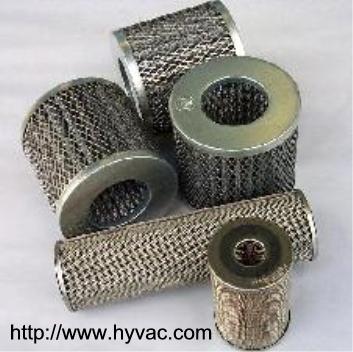| Exhaust filters are often used on oil sealed rotary vane
vacuum pumps. The main reason to use an exhaust filter is to eliminate or minimize oil
mist that can often be a byproduct of the vacuum pumps operation.
Oil mist is often generated by
vacuum pumps for a variety of reasons. The most prevalent and common cause is operating
the vacuum pump at "high" pressures. Generally speaking operating pressures
above 1 Torr or 1000 micron can cause oil mist to be apparent. Oil mist creation is not
unusual and "No the pump isn't on fire." The most common cause is operating the
pump by pumping against an "open" or leaky system. The pump then has very high
gas flows going through it, and in the process will atomize oil molecules (aerosol) and
they will then attempt to exit the pump and, baring no filter media to prevent this, they
will.
If you received an exhaust dome on
one of our vacuum pumps, this is not really a substitute for a true exhaust filter. An
exhaust dome keeps dirt and particulates from getting into your pumps' exhaust port and
then into the oil. It is a very rudimentary filter, and sometimes just a mesh screen.
An exhaust filter or "oil mist
eliminator" is a more advanced filter usually containing a replaceable element that
will stop oil mist on a molecular basis or at least make a good effort at it. Exhaust (oil
mist) discharge can be cut significantly by adding one of these filter items to your
vacuum pump. Not only does it keep the oil mist out of your workspace; it also will keep
the pump oil in the pump where it belongs.
 |
There are two basic types and numerous
variations in these two categories. The first is a standard exhaust filter; generally
coalescing, that will trap most of the oil mist, keep the oil in the pump and exhaust into
the workplace. Coalescing means that the oil drains back into the pump after it condenses
on the insides of the filter element itself. The second type of exhaust filter does the
same as the first, but also includes an exhaust port from the exhaust filter. We call this
a capture filter. With this filter a hose can be hooked up to the filters exhaust port and
any oil mist that gets by the element can be directed via hose connection to a hood to
remove from the workplace.
Big Exhaust Filters
|
| HyVac Filter
elements have been designed to 99.999% DOP efficiency on .2 micron diameter particles.
They are rated at 5 parts per million at 60 Torr maximum carryover.
Oil mist filters are designed
for oil mist, pretty large molecules. If you are dealing with volatile solvents or other
types of work place unfriendly items then the second type of exhaust filter is the filter
for you. These types of filters usually entail a little more installation cost due to need
to run hoses from pump exhaust to the hood but because they present a closed loop to the
hood for exhaust the user is assured a clean environment. |
 |
|
Filters will require changing from
time to time and the frequency depends on the amount of use the filter element in the
filter gets. A simple maintenance program can be put in place once the frequency of actual
changes needed becomes apparent. If a filter is allowed to operate after being all clogged
up over time, then back pressure may start to develop in your pump and may put undo
pressure on the shaft seals or other exit ports from the pump itself. The motor will also
tend to work harder in this situation, so it is important to replace the element every 6
months or so. Again it really depends on the amount of use the system gets. Filter change
out generally should occur when there is a pressure differential of 2.5 psid across the
filter. |
All of the exhaust filters from
HyVac are very easy to install and either thread into the exhaust port of the pump or can
be clamped on in some relatively simple manner.
Do I really need this thing?
Depending on what you are pumping out of your system a good exhaust filter, with a port to
a hood may be a prudent investment. Your pump has less of a chance of running out of oil
with this type of item in place. There is less exposure for local personnel to the exhaust
by products and vapor streams from the pump. It is feasible to port the exhaust directly
to a hood, but then monitoring of the pumps oil level should be made a routine
preventative maintenance practice. Take care to avoid any low spots in the exhaust line as
oil may collect there and again cause back pressure during operation.
Other causes besides
external leaks and operating the pump open to atmosphere are what are known as virtual
leaks. If the pumps exhaust valves are not working correctly then excess oil mist may also
appear in this manner. To check if this is the problem, disconnect your pump and place a
rubber stopper in the intake port and turn the pump on. If the pump goes gurgle, gurgle
and quiets right down this is how it should sound. Try actuating and making sure the gas
ballast valve (knob on top of the pump) is seated in the down position. If instead, after
playing with the rubber stopper for a couple minutes, the gurgling has not gone away, then
it is best to give us a call.
The two types below show regular
exhaust filters which vent to atmosphere at your using location and capture filters which
have threaded fittings to allow the capture of exhaust stream from the filter
itself. It is then possible to port this stream to a hood or out of the building. |